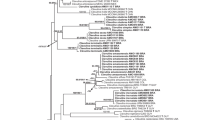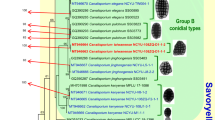Abstract
Cortinarius peraurantiacus is a truffle-like fungus associated with Leptospermum. In the protologue of this species, a second, morphologically different but closely related form is mentioned, found in association with Nothofagus s.l. Phylogenetic analysis of ITS sequences indicates that both the Leptospermum-associated and Nothofagus-associated forms are nested within Cortinarius, but are distinct species. Cortinarius peraurantiacus is closely related to Protoglossum luteum. The southern beech-associated form is sister to an undescribed truffle-like species from Tasmania, and together are related to the New Zealand native mushroom Cortinarius dulciolens. Cortinarius beeverorum is described and illustrated to accommodate the southern beech-associated form.




Similar content being viewed by others
References
Carlson JE, Tulsieram LK, Glaubitz JC, Luk VMK, Kauffeldt CRR (1991) Segregation of random amplified DNA markers in F1 progeny of conifers. Theor Appl Genet 83:194–200. doi:10.1007/BF00226251
Danks M, Lebel T, Vernes K (2010) ‘Cort short on a mountaintop’—Eight new species of sequestrate Cortinarius from sub-alpine Australia and affinities to sections within the genus. Persoonia 24:106–126. doi:10.3767/003158510X512711
Felsenstein J (1985) Confidence limits on phylogenies: an approach using the bootstrap. Evolution 39:783–791
Francis A (2006) The utility of morphological, ITS molecular and combined datasets in estimating the phylogeny of the cortinaroid sequestrate fungi. PhD thesis, Murdoch University, Perth, Western Australia
Francis AA, Bougher NL (2004) Cortinarioid sequestrate (truffle-like) fungi of Western Australia. Aust Mycol 23:1–26
Garnica S, Weiß M, Oertel B, Oberwinkler F (2005) A framework for a phylogenetic classification in the genus Cortinarius (Basidiomycota, Agaricales) derived from morphological and molecular data. Can J Bot 83:1457–1477. doi:10.1139/b05-107
Horak E (1973) Fungi Agaricini Novazelandiae I–V. Beihefte zur Nova Hedwigia 43:1–200
Horton BM (2011) Eucalypt decline and ectomycorrhizal fungal community ecology of Eucalyptus delegatensis forest, Tasmania, Australia. PhD thesis, University of Tasmania, Hobart, Tasmania
Largent DL, Johnson D, Watling R (1977) How to identify mushrooms to genus III: Microscopic features. Mad River Press Inc., Eureka
Lebel T, Syme AE (2012) Sequestrate Agaricus and Macrolepiota from Australia: new combinations and species, and their position in a calibrated phylogeny. Mycologia 104:496–520
Lebel T, Tonkin JE (2007) Australasian species of Macowanites are sequestrate species of Russula (Russulaceae, Basidiomycota). Aust Syst Bot 20:355–381. doi:10.1071/SB07007
Lebel T, Vellinga EC (2013) Description and affinities of a sequestrate Lepiota (Agaricaceae) from Australia. Mycol Prog 12:525–532
Peintner U, Bougher NL, Castellano MA, Moncalvo J-M, Moser MM, Trappe JM, Vilgalys R (2001) Multiple origins of sequestrate fungi related to Cortinarius (Cortinariaceae). Am J Bot 88:2168–2179
Peintner U, Horak E, Moser MM, Vilgalys R (2002) Phylogeny of Rozites, Cuphocybe and Rapacea inferred from ITS and LSU rDNA sequences. Mycologia 94:620–629
Peintner U, Moncalvo J-M, Vilgalys R (2004) Toward a better understanding of the infrageneric relationships in Cortinarius (Agaricales, Basidiomycota). Mycologia 96:1042–1058
Ronquist F, Huelsenbeck JP (2003) MrBayes 3: Bayesian phylogenetic inference under mixed models. Bioinformatics 19:1572–1574. doi:10.1093/bioinformatics/btg180
Soop K (2012) Cortinarioid fungi of New Zealand, eighth revised edition (January 2012). Éditions Scientrix, Mora
Swofford DL (2003) PAUP*. Phylogenetic analysis using parsimony (*and other methods). Version 4. Sinauer Associates, Sunderland, Massachusetts, USA
White TJ, Bruns T, Lee S, Taylor J (1990) Amplification and direct sequencing of fungal ribosomal RNA genes for phylogenetics. In: Innis MA, Gelfand DH, Sninsky JJ, White TJ (eds) PCR protocols: a guide to methods and applications. Academic Press, San Diego, pp 315–324
Acknowledgments
Dr Ross Beever had invaluable, significant input into preliminary examination of material, determination of distinct taxa and discussion of preliminary phylogenetic analyses. We thank staff of PDD and OTA for their assistance in loaning specimens and VR Tomlinson for expert technical help. Some of this work was completed while XYW was in receipt of a JS Tennant Fund Summer Studentship from the Department of Botany, University of Otago. DAO acknowledges support from the Brenda Shore Fund and Performance Based Research Fund through the Department of Botany, University of Otago.
Author information
Authors and Affiliations
Corresponding author
Rights and permissions
About this article
Cite this article
Orlovich, D.A., Wang, X.Y. & Lebel, T. Cortinarius beeverorum, a new species of sequestrate Cortinarius from New Zealand. Mycol Progress 13, 915–921 (2014). https://doi.org/10.1007/s11557-014-0977-z
Received:
Revised:
Accepted:
Published:
Issue Date:
DOI: https://doi.org/10.1007/s11557-014-0977-z




